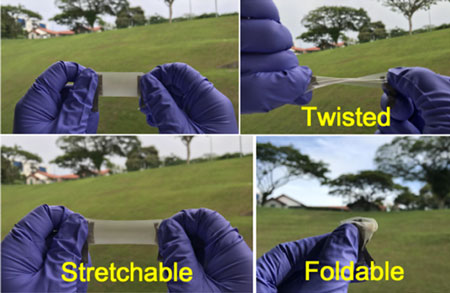| Posted: Dec 04, 2017 | |
Wearable health monitoring with stretchable nanogenerators |
|
| (Nanowerk Spotlight) Nano-sized power generators with piezoelectric properties allows these devices to convert energy into electricity through mechanical stress, stretches and twists of fabrics (read more: "On route to self-powered smart suits"). | |
| Ideally, in order to be fully autonomous, wearable electronics should be powered by human motions. While some motions, such as walking only require flexibility, others such as breathing also require stretchability. (read more: "Nanotechnology in textiles – the new black"). | |
| So far, most of the developed self-powered piezoelectric devices are rigid or have limited lateral stretchability and could not be used to harvest energy from lateral strain, which greatly limits their applications on large strain deformation. | |
| In this new work, researchers in Singapore have successfully fabricated a piezoelectric nanocomposite device with good transparency, high stretchability, and self-powered sensing characteristics. Attached to the human body, it can harvest biomechanical energy and monitor physiological signals. | |
 |
|
| Fabrication process of a stretchable and transparent nanocomposite generator. (Reprinted with permission by American Chemical Society) | |
| The team, led by Pooi See Lee, a professor in the School of Materials Science and Engineering at Nanyang Technological University, reports their findings in ACS Applied Materials & Interfaces ("A Stretchable and Transparent Nanocomposite Nanogenerator for Self-Powered Physiological Monitoring"). | |
| In a previous Nanowerk Spotlight we reported on Lee's group developing a wearable, all-fabric water triboelectric generator that harvests energy from water flow. | |
| In this new paper, the team demonstrates a new stretchable and transparent device that can generate energy from moving body parts by the triboelectric mechanism and can detect the vertical and lateral strain signals by the piezoelectric effect. | |
| The novel device integrates spray-coated metal nanowires as the stretchable electrodes, BaTiO3 embedded into polydimethylsiloxane (PDMS) as the piezoelectric sensing layer, and a thin layer of PDMS as the protective cover and the friction layer. | |
| "By integrating single-electrode triboelectric nanogenerators (TENGs) and nanocomposite-based piezoelectric nanogenerators (PENGs) together, the device not only can effectively generate electricity during the contact-separation process but also provides sensing ability under the compressive and stretching deformation," Lee explains to Nanowerk. | |
 |
|
| Photographs of the fabricated stretchable and transparent nanocomposite generator that is stretchable, twisted, and foldable. (Reprinted with permission by American Chemical Society) | |
| "In particular, the good optical transparency of our device is of significant importance in expanding the realm of current flexible electronics, especially in the applications of self-powered flexible touch screen devices, transparent electronic skins and wearable power sources," says Xiaoliang Chen, a PhD student in Lee's group and first author of the paper. "The most attractive application is that our transparent harvester can be attached to many surfaces – human, robots, textiles etc. – to harvest biomechanical energy and monitor physiological signals." | |
| "Based on this concept, the output from the proposed device can supply energy to power portable electronics," adds Kaushik Parida, PhD, second author of the paper. "Furthermore, the ability of the highly sensitive piezoelectric nanocomposite to deliver different output waveform of electric signals under the stimulus of many kinds of mechanical strain enabled the realization of self-powered healthcare monitoring systems." | |
| To demonstrate that their nanogenerator can act as a self-powered sensor for physiological monitoring, the researchers attached it to the human face to detect the blinking of eyes. The device is subjected to deformation following the dynamic wrinkling of the skin upon eyes blinking, so the output signals gradually increase with the blink force. Besides, the sensor can also monitor the blink rate according to the number of the output peaks. | |
| The researchers expect their nanogenerator – thanks to its good transmittance, high stretchability, excellent sensitivity, and energy-harvesting ability – to contribute to new applications in the field of transparent electronic skins and wearable power sources, sports monitoring or health-monitoring devices. | |
| The device proposed here may provide a simple, low-cost way to detect some tiny physiological signals such as heartbeat pulse, which may possibly be used in medical diagnostics as self-powered sensors. | |
| "Challenges and trends for the future directions of flexible electronics include the development of new materials: light weight, high flexibility and stretchability, biological compatibility and degradable materials; self-powered characteristic: low power consumption and energy generation property; and miniaturization, wireless communication and artificial intelligence," concludes Lee. | |
 By
Michael
Berger
– Michael is author of three books by the Royal Society of Chemistry:
Nano-Society: Pushing the Boundaries of Technology,
Nanotechnology: The Future is Tiny, and
Nanoengineering: The Skills and Tools Making Technology Invisible
Copyright ©
Nanowerk LLC
By
Michael
Berger
– Michael is author of three books by the Royal Society of Chemistry:
Nano-Society: Pushing the Boundaries of Technology,
Nanotechnology: The Future is Tiny, and
Nanoengineering: The Skills and Tools Making Technology Invisible
Copyright ©
Nanowerk LLC
|
|
|
Become a Spotlight guest author! Join our large and growing group of guest contributors. Have you just published a scientific paper or have other exciting developments to share with the nanotechnology community? Here is how to publish on nanowerk.com. |
|
